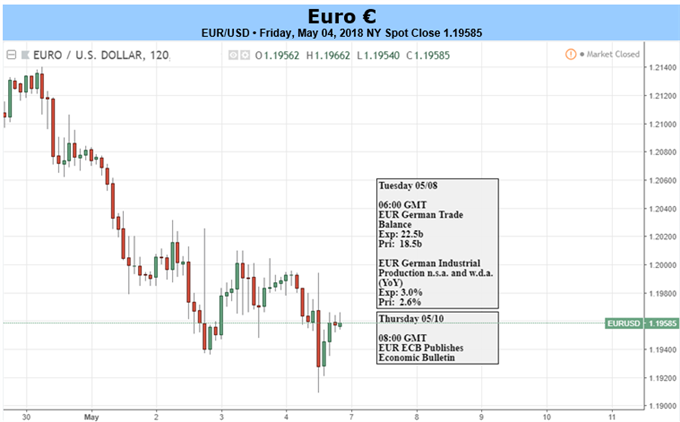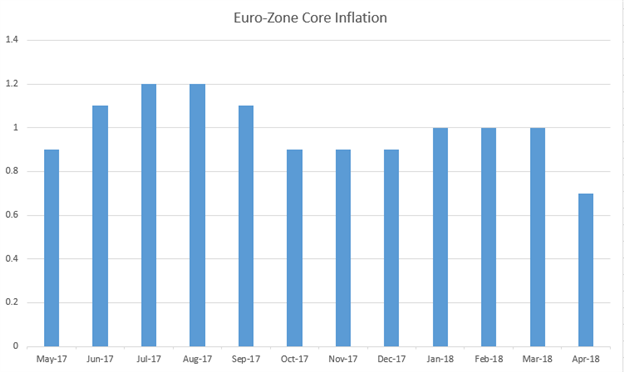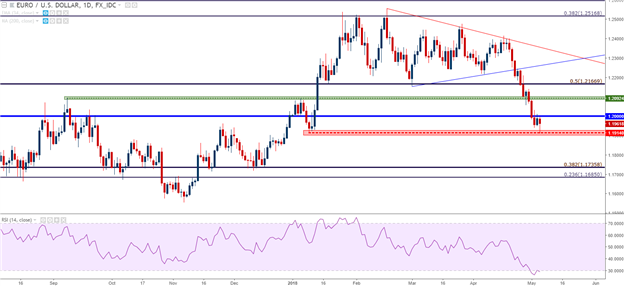
Talking Points:
- Eurozone PMI Confirms Cooling Growth; EURUSD Weakness Set to Continue.
- EURUSD Eases as Euro-Zone Inflation Data Miss Expectations.
- If you’re looking for long-term analysis on the Euro, check out our Quarterly Forecast for the currency.
Fundamental Forecast for the Euro: Neutral
Want to see how other traders are approaching EUR/USD? Check out our IG Client Sentiment indicator.
It was another rough week for the Euro as sellers remained in control against most major currencies. The notable exception being the British Pound, as GBP remains in the midst of an aggressive reversal ahead of next week’s BoE meeting. The Euro has been in a bearish state since mid-April, and those declines hasted around the ECB meeting later in the month when the European Central Bank took a dovish outlook to markets in the face of falling rates of inflation. That theme caught another push this week with the release of April inflation numbers out of Europe. This printed in a rather disappointing fashion, coming in at 1.2% on the headline number, compared to the 1.3% expectation and prior month’s print; while Core CPI came in at .7%, well-below the .9% expectation and the 1% print from last month.
Euro-Zone Core Inflation Falls to Lowest Levels in Over a Year

prepared by James Stanley
Collectively, these falling rates of inflation make for a more complicated backdrop around a Central Bank that’s looking to exit from a massive stimulus program. While growth and inflation remained strong and steady in 2017, that slowing backdrop with inflation falling further away from target may spell trouble for Euro bulls in the near-term.
At the press conference for the April ECB meeting, ECB President Mario Draghi made the comment that while inflation was expected to rise, data had yet to show ‘convincing signs of a sustained upward trend’. This week’s inflation print echoes that sentiment, and with the current QE program set to expire in September, the ECB is running out of time if they actually want to begin plotting a stimulus exit.
We have two more ECB meetings until that September rate decision, which means that data would likely need to show a significant jump to compel the bank to start tightening policy. Looking away from inflation and towards leading indicators, the picture isn’t all that positive. Released earlier this morning was Composite PMI for the Euro-Zone, and this was released at the lowest level since January of 2017. While the indicator printed at 55.1 versus an expectation of 55.2, with any value over 50 indicating expansion; the fact that we’re seeing leading indicators continuing to show a softening or slower backdrop means that we now have a higher probability of QE being extended beyond the program’s current September, 2018 end date.
The economic calendar for next week out of the Euro-Zone is extremely light, with only a smattering of medium-impact announcements on the docket. The predominant focus will be on Germany, as we get factory orders to kick off the week, followed by Retail PMI figures later in the day. Tuesday brings German Trade Balance numbers followed by Industrial Production; and then on Thursday we get ECB meeting minutes from the recent rate decision.
DailyFX Economic Calendar: A Quiet Week for European Economic Data

prepared by James Stanley
Euro Forecast for Next Week
The forecast for the Euro will be set to neutral for next week. While the backdrop around the Euro appears ripe for bearish continuation, the move has come in so quickly that the pair is oversold from a number of angles. In EUR/USD, the pair has been finding short-term resistance around the psychological 1.2000 level; but the fact that bears haven’t been able to show significant pull below the 2018 low indicates that we may have a deeper upside move before the bearish theme might be ready for continuation. We’ve added a level on the below chart, around the price of 1.2093, as this is a swing-high that’s elicited a couple of iterations of prior resistance in the pair. If EUR/USD does pose a re-test of this level, the door opens for short-side setups.
EUR/USD Daily Chart: Oversold with Support Holding at 2018 Swing-Low

Chart prepared by James Stanley
To read more:
Are you looking for longer-term analysis on the U.S. Dollar? Our DailyFX Forecasts for Q1 have a section for each major currency, and we also offer a plethora of resources on USD-pairs such as EUR/USD, GBP/USD, USD/JPY, AUD/USD. Traders can also stay up with near-term positioning via our IG Client Sentiment Indicator.
--- Written by James Stanley, Strategist for DailyFX.com
To receive James Stanley’s analysis directly via email, please SIGN UP HERE
Contact and follow James on Twitter: @JStanleyFX




